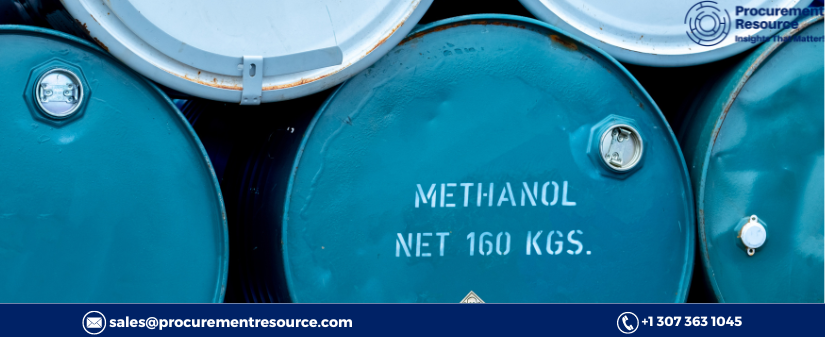Introduction
The Methanol Production Process with Cost Analysis is an essential report for stakeholders in the chemical, energy, and manufacturing industries. This report provides a thorough examination of the methanol production process, highlighting the cost structures and offering insights to help businesses optimize their operations and enhance profitability. Understanding the intricacies of the production process, market drivers, raw material requirements, and associated costs is crucial for companies looking to maintain a competitive edge in this dynamic market.
Request Free Sample – https://www.procurementresource.com/production-cost-report-store/methanol/request-sample
Procurement Resource Assessment of the Methanol Production Process
Procurement Resource offers a comprehensive assessment of the Methanol Production Process, covering every critical aspect from raw material procurement to final product delivery. This assessment includes detailed insights into production methodologies, cost structures, and efficiency optimization strategies. By leveraging this assessment, businesses can gain a clear understanding of the factors influencing production costs and identify opportunities for cost reduction and process improvement.
Understanding Methanol
Methanol is a simple alcohol with the chemical formula CH3OH. It is a light, volatile, colorless, and flammable liquid with a distinctive odor. Methanol is used as a feedstock in the production of formaldehyde, acetic acid, and various other chemicals. It is also used as an alternative fuel source, antifreeze, solvent, and denaturant for ethanol. Its versatility and wide range of applications make it a critical component in various industries.
Market Drivers
Several factors drive the demand for methanol in the global market:
- Growing Demand for Alternative Fuels: The increasing focus on sustainable and renewable energy sources drives the demand for methanol as an alternative fuel. Methanol is used in fuel cells and as a fuel for internal combustion engines, contributing to reduced greenhouse gas emissions.
- Industrial Applications: Methanol’s extensive use in the production of chemicals such as formaldehyde, acetic acid, and methyl tert-butyl ether (MTBE) supports market growth. Its applications in the pharmaceutical and automotive industries further boost demand.
- Technological Advancements: Continuous research and development aimed at improving methanol production methods and expanding its applications contribute to market growth. Technological advancements enhance production efficiency and reduce costs.
- Environmental Regulations: Government policies and regulations promoting the use of cleaner and greener fuels drive the demand for methanol. Incentives and subsidies for renewable energy sources support market expansion.
Raw Materials Requirements
The production of methanol requires specific raw materials, including:
- Natural Gas or Coal: Methanol is primarily produced from natural gas through a process known as steam methane reforming (SMR) or from coal via gasification. The availability and cost of these raw materials significantly impact production efficiency and costs.
- Steam and Oxygen: Steam and oxygen are essential for the reforming and gasification processes, respectively. The quality and availability of these inputs are crucial for achieving high yields and efficient production.
- Catalysts: Various catalysts are used to facilitate the reforming and synthesis reactions in methanol production. The selection and optimization of catalysts are vital for maximizing yield and efficiency.
Costs and Key Process Information
Understanding the costs and key process information is essential for optimizing the methanol production process. This includes:
- Raw Material Costs: The cost of procuring natural gas, coal, steam, and oxygen forms a significant portion of the overall production cost. Fluctuations in the prices of these raw materials can directly impact the cost-effectiveness of the production process.
- Energy Consumption: Methanol production involves energy-intensive processes such as steam reforming, gasification, and synthesis. Monitoring and optimizing energy consumption can lead to substantial cost savings and improved process efficiency.
- Labor and Overheads: The cost of skilled labor and overhead expenses, including maintenance, quality control, and safety measures, contribute to the total production cost. Implementing automation and process optimization can help reduce labor costs and enhance productivity.
- Waste Management: The production of methanol generates waste by-products that need to be managed and disposed of according to environmental regulations. Effective waste management practices can minimize environmental impact and associated costs.
Looking for an Exhaustive and Personalized Report?
Are you looking for an exhaustive and personalized report that could significantly substantiate your business? Procurement Resource offers tailored reports that provide in-depth analysis and insights specific to your business needs. These reports cover all aspects of the methanol production process, from raw material procurement to final product delivery, helping you make informed decisions and achieve cost efficiencies.
Our personalized reports include:
- Customized Cost Analysis: Detailed breakdown of production costs tailored to your specific production setup and operational parameters.
- Process Optimization Recommendations: Expert recommendations for improving process efficiency, reducing waste, and minimizing costs.
- Market Analysis and Forecasts: Comprehensive analysis of market trends, demand drivers, and future growth projections to help you stay ahead of the competition.
- Regulatory Compliance Guidance: Information on relevant environmental and safety regulations to ensure your production processes are compliant and sustainable.
Conclusion
The Methanol Production Process with Cost Analysis report by Procurement Resource is an invaluable resource for businesses operating in the chemical, energy, and manufacturing industries. By understanding the production process, market drivers, raw material requirements, and associated costs, companies can optimize their operations and improve profitability. Whether you are looking to enhance your existing production processes or explore new opportunities in the methanol market, this comprehensive report provides the insights and guidance you need to succeed.
In conclusion, this report is an indispensable tool for industry stakeholders. By understanding the factors influencing production costs and leveraging process optimization strategies, businesses can achieve significant cost savings and operational efficiencies. Staying updated with the latest market trends and regulatory requirements will enable stakeholders to navigate the complexities of the methanol market and maintain a competitive edge.
Whether you are a seasoned industry player or a new entrant, the Methanol Production Process with Cost Analysis report is your key to unlocking the full potential of the methanol market.
